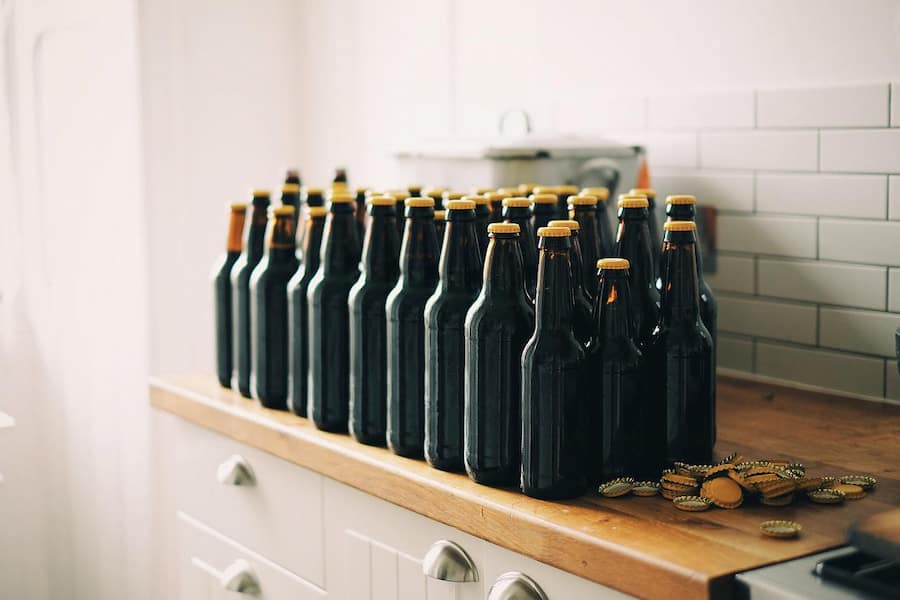If you buy something through a link in our posts, we may get a small share of the sale.
Bottling is the process of transferring beer from a fermenter to a bottle. The main benefit of bottling is that it allows the beer to be carbonated by adding priming sugar before capping. The question beer brewers often ask is can you bottle from a conical fermenter?
Contents
Can You Bottle From a Conical Fermenter?
Yes, bottling from a conical fermenter is possible. The process is made possible by the fact that the fermenter has a spigot at the bottom, which allows for easy transfer of beer. To make the process easier, connect a bottling wand to the spigot that will automatically fill the bottles as you hold them underneath.
The main benefit of bottling from this fermenter is that it is a very sanitary way to package your beer. Bottling from a bulkhead fitting can introduce bacteria and oxygen into your beer, which can lead to off-flavors. By bottling from the spigot, you can ensure that your beer stays sanitary and oxygen-free.
Another thing that makes it possible to bottle from this fermenter is that carbonation can take place in the fermenter. This is because the CO2 produced by fermentation will be trapped in the body of the beer. You can also add a priming sugar solution to the beer before bottling, which will carbonate the beer as it ferments in the bottle.
Steps to Bottle From a Conical Fermenter
Bottling your beer from this fermenter is a simple process that requires a few steps that you should follow. You don’t want to mess up this process and end up with a beer that is over-carbonated or under carbonated. The following are the steps you need to take in order to bottle your beer from the fermenter:

Clean and Sanitize All of Your Bottling Equipment
This includes your, siphon hose, racking cane, and bottles. You don’t want to introduce any bacteria into your beer, so it is important to clean and sanitize all of your equipment.
You can use no-rinse cleaner sanitizers since they are easy to use and don’t require you to rinse off your equipment. All you need to do is soak your equipment in the sanitizer solution and then let it air dry.
Attach the Siphon Hose to the Spigot
You will need to use a siphon hose to transfer the beer from the fermenter to the bottling bucket. Ensure that the siphon hose is airtight so that no oxygen can get into the beer.
If you are using an auto-siphon, insert it into the spigot and then pump it a few times to start the siphon. Once the beer starts flowing, direct it to the bottle, you are holding underneath. At this point, you need to be careful since the beer will be under pressure and can foam up.
Fill the Bottles
As the beer is being siphoned into the bottling bucket, you can start filling up the bottles. Fill them up to about an inch from the top, leaving some headspace for the carbonation. You can use a bottle filler that is attached to the siphon hose to make the process easier.
The headspace is important since it allows the carbonation to take place in the bottle. If you don’t leave enough headspace, your bottles can explode from the pressure, and you will end up with a big mess.
Cap the Bottles
Once the bottles are filled, you will need to cap them. You can do this by hand or use a capping machine. If you are capping by hand, be sure to sanitize the bottle caps first. Most brewers like using oxygen-barrier bottle caps since they keep the beer from oxidizing.
Store the Bottles in a Cool, Dark Place
After capping the bottles, store them in a cool, dark place so that they can carbonate properly. The ideal temperature for carbonation is around 60-70 degrees Fahrenheit. You will need to wait at least two weeks for the beer to carbonate properly. You can then refrigerate the bottles and enjoy your beer!

Factors to Consider When Bottling From a Conical Fermenter
There are a few factors that you need to consider when bottling your beer from the fermenter so that you don’t mess up the process:
- The Temperature of the Beer: If the beer is too warm; it can over-carbonate in the bottle and explode. Ensure it is at an optimal temperature for carbonation, around 60-70 degrees Fahrenheit.
- The Amount of Headspace: You need to leave enough headspace in the bottle for the carbonation to take place.
Frequently Asked Questions
What Is the Benefit of a Conical Fermenter?
A conical fermenter is a worthy investment. The main benefit of using this type of fermenter is that it allows for a consistently warm environment. The cone-shaped bottom collects all of the yeast and trub, so you don’t have to transfer the beer to another vessel for secondary fermentation.
When Can I Bottle After Fermenting?
Two weeks is the minimum time you should wait to bottle your beer. This gives the yeast enough time to eat all the sugars and carbonate the beer.
Conclusion
It is possible to bottle your beer from a conical fermenter; however, you need to be careful and follow the proper steps. This will ensure that your beer turns out well and is safe to drink. It also helps to prevent any messes that could occur if something goes wrong.

